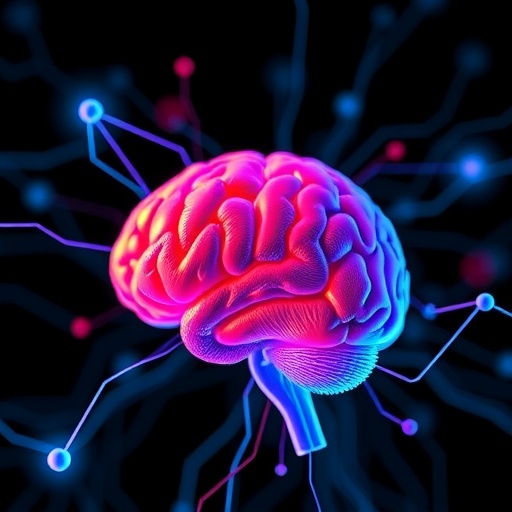In a groundbreaking collaborative effort between the Icahn School of Medicine at Mount Sinai and the University of Texas at El Paso, scientists have unveiled a pioneering computational framework that sheds unprecedented light on the intricate workings of the striatum, a critical brain region responsible for shaping the everyday decisions that govern human behavior. This innovative model dives into the nuanced role of a specialized striatal substructure known as the striosomal compartment, revealing insights that could transform therapeutic approaches to a host of psychiatric disorders marked by impaired decision-making, such as post-traumatic stress disorder (PTSD) and substance use disorders.
The study, recently published in Nature Communications, offers a detailed exploration into how modulating the neural activity of the striosomes can influence decision-making processes and potentially guide interventions designed to recalibrate dysfunctional cognitive patterns. Unlike previous research that broadly acknowledged the striatum’s involvement in cost-benefit analyses during decision-making, the present work provides the first computationally grounded explanation of how striosomal circuits are precisely engaged in these processes, both in healthy individuals and those suffering from psychiatric impairments.
At the core of this research lies the recognition that the striatum is not a homogenous entity but is comprised of two anatomically and neurochemically distinct compartments: the striosomes and the surrounding matrix. Though anatomical delineations have been known for decades, their functional significance remained enigmatic. Through a sophisticated integration of biological insights, mathematical modeling, and big data analytics, the research team constructed a model that delineates the distinct regulatory roles these compartments play in neural decision-making circuitry.
Central to the model’s innovation is the elucidation of how neural information encoding relevant decision-making factors streams into the striosomes, where dynamic modulation occurs to determine which factors ultimately influence a given choice. The researchers discovered that elevated striosomal activity simplifies decision strategies, typically driving choices based on a limited set of factors, often just one. This lean approach to decision-making fosters rapid evaluations but carries the risk of impulsivity when striosomal activity is excessively high, precipitating rash and potentially harmful decisions.
Conversely, the model demonstrates that lower levels of striosomal activation facilitate more complex, multidimensional decision-making. Here, the brain considers a broader array of factors, leading to more deliberate and nuanced judgments. However, when striosomal activity falls too low, the system becomes overwhelmed by excessive inputs, which can stall the decision-making process entirely—a phenomenon termed “analysis paralysis,” where the neural circuitry struggles to settle on a definitive course of action amidst the competing influences.
These insights offer a revolutionary framework to understand how psychiatric disorders may be characterized by dysregulated striosomal activity levels, thereby impairing cost-benefit decision-making. For instance, disorders like PTSD and substance use are theorized to be associated with hyperactive striosomal circuits, which prioritize potential rewards while neglecting corresponding risks, fostering risky and impulsive behaviors. In stark contrast, depressive disorders may stem from hypoactive striosomal states, manifesting as indecisiveness and prolonged contemplation due to the overwhelming consideration of numerous factors without clear resolution.
The implications of modulating striosomal activity as a therapeutic target are profound. By fine-tuning this neural activity, clinicians might promote a recalibration of decision-making patterns, steering patients toward healthier choices and reducing maladaptive behaviors characteristic of various psychiatric conditions. The computational tool introduced by the team not only offers diagnostic clarity into the neural underpinnings of mental illnesses but opens doors for the rational design of interventions aimed at restoring balanced striosomal functions.
This venture represents a symbiotic convergence of multiple disciplines, merging neuroscience with applied mathematics, cognitive psychology, and computational modeling, underscoring the power of interdisciplinary approaches to unravel the complexities of brain function. The collaboration extends across notable institutions including the Friedman Brain Institute and the Center for Translational Medicine and Pharmacology, exemplifying the promising future of integrated biomedical research.
Beyond its theoretical contributions, this model lays a foundation for empirical investigations to measure striosomal activity in vivo and evaluate the effects of potential pharmacological or neuromodulatory therapies aimed at restoring optimal decision-space dynamics. Such translational pipelines are critical for bridging computational hypotheses with clinical applications, ultimately enhancing patient outcomes.
Furthermore, the sophistication of this model ushers in new possibilities for personalized medicine, where individual patterns of striosomal function could inform tailored treatment plans. By measuring and adjusting activity parameters specific to an individual’s neural profile, treatments can be more precisely aligned with their unique neurobiological signatures, advancing efficacy and minimizing side effects.
The striatum’s role in coordinating motivation, reward processing, motor control, and decision-making is multifaceted, and this work adds a pivotal layer of knowledge by explicitly implicating the striosomal compartment as a gatekeeper that filters the multiplicity of environmental and internal factors competing for cognitive resources. It elucidates how the brain balances simplicity and complexity in decision-making to adapt successfully to diverse contexts.
Published on August 14, 2025, this study not only fills a longstanding gap in our understanding of striatal function but also inspires a paradigm shift in considering how neural computational frameworks can inform mental health interventions. The potential to modulate the decision-space model dynamically marks a new frontier for psychiatric research and clinical neuroscience.
Given the complexity and sophistication of the human brain, the advancement represented in this work is a testament to the power of computational models, which serve as indispensable tools to decipher the tangled neural webs underlying behavior. As scholars and clinicians probe deeper into the striatum’s compartmental specialization, the promise of unlocking new strategies to treat and rehabilitate psychiatric disorders becomes tantalizingly achievable.
The research heralds a future where mental health disorders are approached not only through symptomatic treatment but through targeted modulation of fundamental neural circuits, guided by robust mathematical and biological models. In doing so, it paves the way for more effective, nuanced, and scientifically grounded therapies that could transform the landscape of psychiatric care.
Subject of Research: People
Article Title: A decision-space model explains context-specific decision-making
News Publication Date: 14-Aug-2025
Web References: https://www.nature.com/articles/s41467-025-61466-x
References: 10.1038/s41467-025-61466-x
Keywords: Affective disorders, Modeling, Applied mathematics, Ventral striatum, Dorsal striatum, Social decision making




